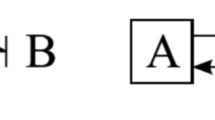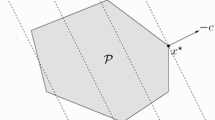Abstract
In cyber-physical and automated manufacturing systems, parts scheduling and production control must incorporate feedback loops to consider the real-time shop floor state. Bond-graph modeling strategies allow modeling production control systems with feedback loops using flow and effort variables. Despite its applicability, there is a paucity of works applying this technique to this aim. The effort variable does not have a concrete interpretation in the few extant models. Often, buffers are modeled with infinite capacity, and a minimum function is used in the coupling interface between the machine and the buffer. These characteristics introduce nonlinearities, increasing the control design complexity. This paper proposes modifications to the existing bond-graph models for representing manufacturing entities to overcome these limitations, enhancing the usability of the modeling strategy. The proposal is applied to a 4-station shop floor as a proof of concept. The controllers are designed based on an optimal control approach coupled with parameters optimization so that engineers can adjust the capacity of the material sources and machines to desired levels. The proposal contributes to the literature by considering buffers with limited capacity, optimizing the control parameters, and designing responsive production systems with different shop floor configurations. These assets are relevant to Industry 4.0.

















Similar content being viewed by others
References
Wang S, Wan J, Zhang D, Li D, Zhang C (2016) Towards smart factory for industry 4.0: a self-organized multi-agent system with big data based feedback and coordination. Comput Netw 101:158–168. https://doi.org/10.1016/j.comnet.2015.12.017
Ivanov D, Sethi S, Dolgui A, Sokolov B (2018) A survey on control theory applications to operational systems, supply chain management, and industry 4.0. Ann Rev Control 46:134–147. https://doi.org/10.1016/j.arcontrol.2018.10.014
Sagawa JK, Mušič G (2019) Towards the use of bond graphs for manufacturing control: design of controllers. Int J Prod Econ 214:53–72. https://doi.org/10.1016/j.ijpe.2019.03.017
Bortolini M, Galizia FG, Mora C (2018) Reconfigurable manufacturing systems: literature review and research trend. J Manuf Syst 49:93–106. https://doi.org/10.1016/j.jmsy.2018.09.005
Fragapane G, Ivanov D, Peron M, Sgarbossa F, Strandhagen JO (2002) Increasing flexibility and productivity in industry 4.0 production networks with autonomous mobile robots and smart intralogistics. Ann Oper Res. https://doi.org/10.1007/s10479-020-03526-7
Lee J, Noh S, Kim H-J, Kang Y-S (2018) Implementation of cyber-physical production systems for quality prediction and operation control in metal casting. Sensors 18(5):1428. https://doi.org/10.3390/s18051428
Lu Y (2017) Industry 4.0: a survey on technologies, applications and open research issues. J Ind Inf Integr 6:1–10. https://doi.org/10.1016/j.jii.2017.04.005
Derigent W, Cardin O, Trentesaux D (2020) Industry 4.0: contributions of holonic manufacturing control architectures and future challenges. J Intell Manuf. https://doi.org/10.1007/s10845-020-01532-x
Lee EA (2008) Cyber physical systems: design challenges. In: 2008 11th IEEE international symposium on object and component-oriented real-time distributed computing (ISORC). IEEE, pp 363–369. https://doi.org/10.1109/ISORC.2008.25
Dilts DM, Boyd NP, Whorms HH (1991) The evolution of control architectures for automated manufacturing systems. J Manuf Syst 10(1):79–93. https://doi.org/10.1016/0278-6125(91)90049-8
Grundstein S, Freitag M, Scholz-Reiter B (2017) A new method for autonomous control of complex job shops—integrating order release, sequencing and capacity control to meet due dates. J Manuf Syst 42:11–28. https://doi.org/10.1016/j.jmsy.2016.10.006
Singh R, Bera TK (2019) Bond graph approach for dynamic modelling of the biped robot and application to obstacle avoidance. J Braz Soc Mech Sci Eng. https://doi.org/10.1007/s40430-019-1957-7
Neto MM, Góes LCS (2018) Use of LMS amesim® model and a bond graph support to predict behavior impacts of typical failures in an aircraft hydraulic brake system. J Braz Soc Mech Sci Eng. https://doi.org/10.1007/s40430-018-1332-0
Fan X, Fang M, He Y, Song T (2019) Modeling and dynamic analysis of a pilot-operated pressure-regulating solenoid valve used in automatic transmission with bond graphs. J Braz Soc Mech Sci Eng. https://doi.org/10.1007/s40430-019-1875-8
Ferney M (2000) Modelling and controlling product manufacturing systems using bond-graphs and state equations: continuous systems and discrete systems which can be represented by continuous models. Prod Plan Control 11(1):7–19. https://doi.org/10.1080/095372800232441
Sprodowski T, Sagawa JK, Pannek J (2018) Frequency based model predictive control of a manufacturing system. IFAC-PapersOnLine 51(2):801–806. https://doi.org/10.1016/j.ifacol.2018.04.012
Sprodowski T, Sagawa JK, Maluf AS, Freitag M, Pannek J (2020) A multi-product job shop scenario utilising model predictive control. Expert Syst Appl 162:113734. https://doi.org/10.1016/j.eswa.2020.113734
Lair PO, Ferney M, Zerhouni N (1997) Using bond graphs to model production systems with machine failure. IFAC Proc Vol 30(6):151–156. https://doi.org/10.1016/s1474-6670(17)43357-x
Sagawa JK, Nagano MS (2013) Dynamic models for production control and scheduling: A brief review. In: 2013 12th Mexican international conference on artificial intelligence. IEEE, Mexico. https://doi.org/10.1109/micai.2013.10
Maluf AS, Sagawa JK, Borges RF (2022) Toward the use of bond graphs for manufacturing control: comparison of existing models. Int J Adv Manuf Technol. https://doi.org/10.1007/s00170-022-09401-y
Sagawa JK, Nagano MS (2015) Modeling the dynamics of a multi-product manufacturing system: a real case application. Eur J Oper Res 244(2):624–636. https://doi.org/10.1016/j.ejor.2015.01.017
Das S (2009) Mechatronic modeling and simulation using bond graphs. CRC Press, New York. https://doi.org/10.1201/b15831
Samantaray AK, Bouamama BO (2008) Model-based process supervision: a bond graph approach. Springer, London. https://doi.org/10.1007/978-1-84800-159-6
Sagawa JK, Nagano MS (2015) Applying bond graphs for modelling the manufacturing dynamics. IFAC-PapersOnLine 48(3):2047–2052. https://doi.org/10.1016/j.ifacol.2015.06.390
Sagawa JK, Nagano MS (2015) A review on the dynamic decision models for manufacturing and supply chain. In: Decision models in engineering and management. Springer, Switzerland, pp 77–108. https://doi.org/10.1007/978-3-319-11949-6_5
Alla H, David R (1989) Modeling of production systems by continuous petri nets. In: CAD/CAM robotics and factories of the future. Springer, Berlin, Heidelberg, pp 344–348
Ogata K (2011) Modern control engineering. Prentice Hall, New York
Franklin GF, Powell JD, Emami-Naeini A (2009) Feedback control of dynamic systems. Prentice Hall, New York
Colombo FT, da Silva MM (2022) A comparison between gain-scheduling linear quadratic regulator and model predictive control for a manipulator with flexible components. Proc Inst Mech Eng Part I J Syst Control Eng 236(7):1285–1293. https://doi.org/10.1177/09596518221087805
Ahad MA, Iqbal N, Ahmad SM et al (2021) Detailed modelling and LQG\LTR control of a 2-DOF radial active magnetic bearing for rigid rotor. J Braz Soc Mech Sci Eng 43:234. https://doi.org/10.1007/s40430-021-02951-4
Rao LVVG, Narayanan S (2020) Optimal response of half car vehicle model with sky-hook damper using LQR with look ahead preview control. J Braz Soc Mech Sci Eng 42:471. https://doi.org/10.1007/s40430-020-02552-7
Sarir H (2020) Planning and inventory control based on identification system and pid/lqr controller. J Theor Appl Inf Technol 98(24):3921–3931
Taparia R, Janardhanan S, Gupta R (2020) Lqr control of multiple product inventory systems for profit and warehouse capacity maximization. In: 2020 International conference on emerging trends in communication, control and computing (ICONC3). IEEE, pp 1–5. https://doi.org/10.1109/ICONC345789.2020.9117511
Hatami-Marbini A, Sajadi SM, Malekpour H (2020) Optimal control and simulation for production planning of network failure-prone manufacturing systems with perishable goods. Comput Ind Eng 146:106614. https://doi.org/10.1016/j.cie.2020.106614
Souza DA, de Mesquita VA, Reis LLN, Silva WA, Batista JG (2021) Optimal LQI and PID synthesis for speed control of switched reluctance motor using metaheuristic techniques. Int J Control Autom Syst 19(1):221–229
Skogestad S, Postlethwaite I (2007) Multivariable feedback control: analysis and design. Wiley, New York
Awouda AEA, Mamat RB (2010) Refine pid tuning rule using itae criteria. In: 2010 The 2nd International conference on computer and automation engineering (ICCAE), vol 5, pp 171–176. https://doi.org/10.1109/ICCAE.2010.5451484
Nie Y, Zhang Y, Zhao Y, Fang B, Zhang L (2019) Wide-area optimal damping control for power systems based on the itae criterion. Int J Electr Power Energy Syst 106:192–200. https://doi.org/10.1016/j.ijepes.2018.09.036
Hopp WJ, Spearman ML (2004) To pull or not to pull: What is the question? Manuf Serv Oper Manag 6(2):133–148. https://doi.org/10.1287/msom.1030.0028
Cheng TC, Podolsky S (1993) Just-in-time manufacturing: an introduction. Chapman & Hall, London
Funding
This study was financed in part by the Coordenação de Aperfeiçoamento de Pessoal de Nível Superior - Brasil (CAPES) - Finance Code 001. Moreover, this work was supported by the FAPESP under Grant 2019/12023-1. Maíra M. da Silva is also grateful for her CNPq Grant 303884/2021-5.
Author information
Authors and Affiliations
Corresponding author
Additional information
Technical Editor: Rogério Sales Gonçalves.
Publisher's Note
Springer Nature remains neutral with regard to jurisdictional claims in published maps and institutional affiliations.
Rights and permissions
Springer Nature or its licensor holds exclusive rights to this article under a publishing agreement with the author(s) or other rightsholder(s); author self-archiving of the accepted manuscript version of this article is solely governed by the terms of such publishing agreement and applicable law.
About this article
Cite this article
Maluf, A.S., Sagawa, J.K., Tavares Neto, R.F. et al. Toward the use of bond graphs for manufacturing control: improving existing models. J Braz. Soc. Mech. Sci. Eng. 44, 521 (2022). https://doi.org/10.1007/s40430-022-03827-x
Received:
Accepted:
Published:
DOI: https://doi.org/10.1007/s40430-022-03827-x




